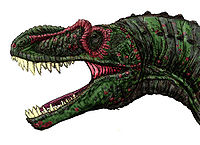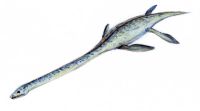
Demopolis Chalk Formation
Encyclopedia
The Demopolis Chalk Formation is a geological formation in North America
, within the U.S.
states of Alabama
, Mississippi
, and Tennessee
. The chalk
was formed by pelagic sediments
deposited along the eastern edge of the Mississippi embayment
during the middle Campanian
stage of the Late Cretaceous
. It is a unit of the Selma Group
and consists of the upper Bluffport Marl Member and a lower unnamed member. Dinosaur
and mosasaur
remains are among the fossils that have been recovered from the Demopolis Chalk Formation.
. Possible indeterminate tyrannosaurid remains have been found in Alabama
.
North America
North America is a continent wholly within the Northern Hemisphere and almost wholly within the Western Hemisphere. It is also considered a northern subcontinent of the Americas...
, within the U.S.
United States
The United States of America is a federal constitutional republic comprising fifty states and a federal district...
states of Alabama
Alabama
Alabama is a state located in the southeastern region of the United States. It is bordered by Tennessee to the north, Georgia to the east, Florida and the Gulf of Mexico to the south, and Mississippi to the west. Alabama ranks 30th in total land area and ranks second in the size of its inland...
, Mississippi
Mississippi
Mississippi is a U.S. state located in the Southern United States. Jackson is the state capital and largest city. The name of the state derives from the Mississippi River, which flows along its western boundary, whose name comes from the Ojibwe word misi-ziibi...
, and Tennessee
Tennessee
Tennessee is a U.S. state located in the Southeastern United States. It has a population of 6,346,105, making it the nation's 17th-largest state by population, and covers , making it the 36th-largest by total land area...
. The chalk
Chalk
Chalk is a soft, white, porous sedimentary rock, a form of limestone composed of the mineral calcite. Calcite is calcium carbonate or CaCO3. It forms under reasonably deep marine conditions from the gradual accumulation of minute calcite plates shed from micro-organisms called coccolithophores....
was formed by pelagic sediments
Pelagic sediments
Pelagic sediment or pelagite is a fine-grained sediment that has accumulated by the settling of particles through the water column to the ocean floor beneath the open ocean far from land. These particles consist primarily of either the microscopic, calcareous or siliceous shells of phytoplankton or...
deposited along the eastern edge of the Mississippi embayment
Mississippi embayment
The Mississippi Embayment is a physiographic feature in the south-central United States, part of the Mississippi Alluvial Plain. It is essentially a northward continuation of the fluvial sediments of the Mississippi River Delta to its confluence with the Ohio River at Cairo, Illinois. The embayment...
during the middle Campanian
Campanian
The Campanian is, in the ICS' geologic timescale, the fifth of six ages of the Late Cretaceous epoch . The Campanian spans the time from 83.5 ± 0.7 Ma to 70.6 ± 0.6 Ma ...
stage of the Late Cretaceous
Late Cretaceous
The Late Cretaceous is the younger of two epochs into which the Cretaceous period is divided in the geologic timescale. Rock strata from this epoch form the Upper Cretaceous series...
. It is a unit of the Selma Group
Selma Group
The Selma Group is a geological formation in North America, within the U.S. states of Alabama, Mississippi, and Tennessee. The strata date from the Santonian to the Maastrichtian stages of the Late Cretaceous. The group is composed of, in ascending order, the Mooreville Chalk Formation, Demopolis...
and consists of the upper Bluffport Marl Member and a lower unnamed member. Dinosaur
Dinosaur
Dinosaurs are a diverse group of animals of the clade and superorder Dinosauria. They were the dominant terrestrial vertebrates for over 160 million years, from the late Triassic period until the end of the Cretaceous , when the Cretaceous–Paleogene extinction event led to the extinction of...
and mosasaur
Mosasaur
Mosasaurs are large extinct marine lizards. The first fossil remains were discovered in a limestone quarry at Maastricht on the Meuse in 1764...
remains are among the fossils that have been recovered from the Demopolis Chalk Formation.
Cartilaginous fish
| Cartilaginous fish of the Demopolis Chalk Formation | ||||
|---|---|---|---|---|
| Genus | Species | Presence | Notes | Images |
Cretolamna |
C. appendiculata |
A cretoxyrhinid Cretoxyrhinidae Cretoxyrhinidae is an extinct family of sharks. Members of this family include Cretoxyrhina, a genus from the Cretaceous, and Palaeocarcharodon, a possible ancestor of the Great white shark and Carcharodon megalodon, possibly the largest shark to have lived.-External links:*... |
 |
|
Scapanorhynchus Scapanorhynchus Scapanorhynchus is an extinct genus of shark from the Cretaceous era. Their extreme similarities to the living goblin shark, Mitsukurina owstoni, lead some experts to consider reclassifying it as Scapanorhynchus owstoni... |
Scapanorhynchus sp. |
A mitsukurinid Mitsukurinidae Mitsukurinidae, also called goblin sharks is a family of sharks with one living genus, Mitsukurina, and three extinct genera: Anomotodon, Pseudoscapanorhynchus and Scapanorhynchus, though some taxonomists consider Scapanorhynchus to be a synonym of Mitsukurina... |
||
Squalicorax Squalicorax Squalicorax is a genus of extinct lamniform shark known to have lived during the Cretaceous period. A fully articulated 1.9 m long fossil skeleton of Squalicorax has been found in Kansas, evidence of its presence in the Western Interior Seaway... |
S. kaupi |
Anacoracids Anacoracidae Anacoracidae is an extinct shark family in the order Lamniformes.-References:* H. Cappetta, Handbook of Paleoichthyology... |
||
S. pristodontus |
||||
Ischyrhiza Ischyrhiza Ischyrhiza is an extinct genus of cartilaginous fish from the Cretaceous and Paleogene belonging to the primitive Batoidea family Sclerorhynchidae.-Sources:* Fossils by David Ward * accessed on 8/21/09... |
I. mira |
A sclerorhynchid Sclerorhynchidae Sclerorhynchidae is an extinct family of cartilaginous fish from the Cretaceous and Paleogene belonging to the primitive Batoidea suborder Sclerorhynchoidea.-Sources:* accessed on 8/21/09... |
||
Bony fish
| Bony fish of the Demopolis Chalk Formation | ||||
|---|---|---|---|---|
| Genus | Species | Presence | Notes | Images |
Enchodus Enchodus Enchodus is an extinct genus of bony fish. It flourished during the Upper Cretaceous and was small to medium in size. One of the genus' most notable attributes are the large "fangs" at the front of the upper and lower jaws and on the palatine bones, leading to its misleading nickname among fossil... |
E. petrosus |
An enchodontid |
 |
|
Protosphyraena Protosphyraena Protosphyraena is a fossil genus of swordfish-like marine fish, that throve worldwide during the Upper Cretaceous Period . Though fossil remains of this taxon have been found in both Europe and Asia, it is perhaps best known from the Smoky Hill Member of the Niobrara Chalk Formation of Kansas... |
P. gladius |
A xiphiid Swordfish Swordfish , also known as broadbill in some countries, are large, highly migratory, predatory fish characterized by a long, flat bill. They are a popular sport fish of the billfish category, though elusive. Swordfish are elongated, round-bodied, and lose all teeth and scales by adulthood... |
||
Xiphactinus Xiphactinus Xiphactinus was a large, 4.5 to 6 m long predatory bony fish that lived in the Western Interior Sea, over what is now the middle of North America, during the Late Cretaceous. When alive, the fish would have resembled a gargantuan, fanged tarpon... |
X. vetus |
An ichthyodectid Ichthyodectidae The family Ichthyodectidae was a family of marine actinopterygian fish. Sometimes classified in the primitive bony fish order Pachycormiformes, they are today generally regarded as members of the "bulldog fish" order Ichthyodectiformes in the far more advanced Osteoglossomorpha... |
||
Dinosaurs
Indeterminate hadrosaurid remains have been found in TennesseeTennessee
Tennessee is a U.S. state located in the Southeastern United States. It has a population of 6,346,105, making it the nation's 17th-largest state by population, and covers , making it the 36th-largest by total land area...
. Possible indeterminate tyrannosaurid remains have been found in Alabama
Alabama
Alabama is a state located in the southeastern region of the United States. It is bordered by Tennessee to the north, Georgia to the east, Florida and the Gulf of Mexico to the south, and Mississippi to the west. Alabama ranks 30th in total land area and ranks second in the size of its inland...
.
| Dinosaur Dinosaur Dinosaurs are a diverse group of animals of the clade and superorder Dinosauria. They were the dominant terrestrial vertebrates for over 160 million years, from the late Triassic period until the end of the Cretaceous , when the Cretaceous–Paleogene extinction event led to the extinction of... s of the Demopolis Chalk Formation |
||||
|---|---|---|---|---|
| Genus | Species | Presence | Notes | Images |
Appalachiosaurus Appalachiosaurus Appalachiosaurus is a genus of tyrannosauroid theropod dinosaur from the Late Cretaceous Period of eastern North America. Like almost all theropods, it was a bipedal predator. Only a juvenile skeleton has been found, representing an animal over 7 meters long and weighing over... |
A. montgomeriensis |
Geographically present in Alabama Alabama Alabama is a state located in the southeastern region of the United States. It is bordered by Tennessee to the north, Georgia to the east, Florida and the Gulf of Mexico to the south, and Mississippi to the west. Alabama ranks 30th in total land area and ranks second in the size of its inland... . |
A tyrannosauroid |
 |
Mosasaurs
| Mosasaurs of the Demopolis Chalk Formation | ||||
|---|---|---|---|---|
| Genus | Species | Presence | Notes | Images |
Mosasaurus Mosasaurus Mosasaurus is a genus of mosasaur, carnivorous, aquatic lizards, somewhat resembling flippered crocodiles, with elongated heavy jaws. The genus existed during the Maastrichtian age of the Cretaceous period , around 70-65 millions years ago in the area of modern Western Europe and North America... |
M. conodon |
A mosasaurine |
 |
|
Plioplatecarpus Plioplatecarpus Plioplatecarpus is a genus of mosasaur lizard. Like all mosasaurs, it lived in the late Cretaceous period, about 83.5 million years ago.-Description:... |
P. primaevus |
A plioplatecarpine |
||
Prognathodon Prognathodon Prognathodon is an extinct genus of marine reptile belonging to the mosasaur family. It had protective bony rings surrounding its eye sockets, indicating it lived in deep water. its fossil remains have been found in the U.S.A , Canada , Belgium, New Zealand, Morocco and The Netherlands... |
P. rapax |
A mosasaurine |
||
P. solvayi |
||||
Plesiosaurs
| Plesiosaur Plesiosaur Plesiosauroidea is an extinct clade of carnivorous plesiosaur marine reptiles. Plesiosauroids, are known from the Jurassic and Cretaceous Periods... s of the Demopolis Chalk Formation |
||||
|---|---|---|---|---|
| Genus | Species | Presence | Notes | Images |
Elasmosaurus Elasmosaurus Elasmosaurus + σαυρος sauros 'lizard') is a genus of plesiosaur with an extremely long neck that lived in the Late Cretaceous period , 80.5 million years ago.-Description:... |
Elasmosaurus sp. |
An elasmosaurid Elasmosauridae Elasmosauridae was the family of plesiosaurs. They had the longest necks of the plesiosaurs and survived from the Late Triassic to the end of the Cretaceous. They had a diet of fish and shelless cephalopods.-Size:... |
 |
|

